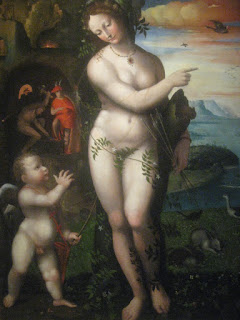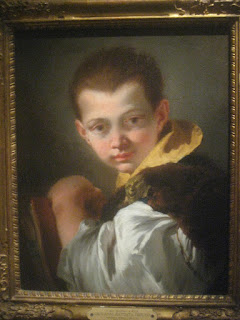Bartholomeus van der Helst "Homo Bulla: A Boy Blowing Bubbles" 1665
The Dutch and Flemish Collections
Dutch and Flemish artists were celebrated for their command of detail and faithful depiction of nature. This can be seen in Marinus van Reymerswaele’s The Lawyer’s Office, which refers to an actual lawsuit filed in 1526. The documents of this court case are recorded with amazing precision on the background wall.
Also in this vein of realism is the Serpents and Insectsby Ottho Marseus van Schrieck who practiced an odd branch of still life tradition developed by Netherlandish painters; he raised the reptiles and rare insects himself in a vivarium, and copied them from life.
Though the Italian Renaissance was unfolding far away and the North had their own distinctive style, a significant number of Northern artists made the voyage across the Alps. They returned home profoundly impressed by their encounter with Michelangelo and the classical heritage, as can be seen in Maerten van Heemskerk’s Apollo and the Muses.
Bartholomeus van der Helst "Homo Bulla: A Boy Blowing Bubbles" 1665
The Lawyer's Office Reymerswaele, Marinus van, 1545
The Italian Collection
NOMA’s Italian painting collection from the early Renaissance through the
18th Century is particularly distinguished. A group of panel paintings in
tempera with gilded backgrounds, some as early as the 1300s, includes Bartolomeo
Vivarini’s altarpiece of the Coronation of the Virgin.
Although oil painting was invented in the north of Europe, it was the
Venetian painters who first understood the potential of this new technique for
brilliance of color, light and texture. Portraits by Lorenzo Lotto and Tiepolo
show off this virtuosity with oil paint, as well as an insight into the subjects
of the portraits that carries across the centuries.
From Genoa comes Luca Cambiaso’s sumptuous treatment of the female nude in
the Allegory of Venus and Earthly Vanity. The melodrama of Death Comes to the
Banquet Table by Giovanni Martinelli is heightened by the sharp contours and
clarity of form that were typical of Florentine painting of the 17th
Century.
Adoration of the Christ Child and Annunciation to the Shepherds Luini,
Bernardino, circa 1520-1525
Boy Holding a Book (Portrait of Lorenzo Tiepolo) Tiepolo, Giovanni
Battista, circa 1747-50



























































No comments:
Post a Comment